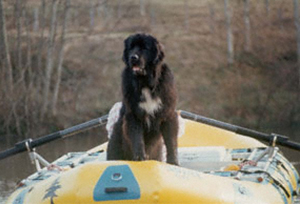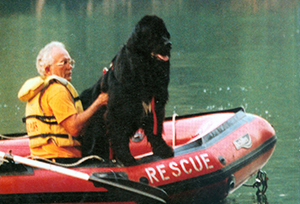by Rebecca Stanevich
Water rescue means something different to Tiptop's Flow Jo than if does to many Newfs. Flo is a search and rescue dog. She is trained and certified in air scenting. This means that she is trained to search for and find any human scent in her designated search area.
For the past year, Flo has been in training to find drowning victims. This is considered a specialty or advanced training area for the dogs. They should first be skilled at finding live people, either by airscenting or by tracking. The dogs playa very valuable role during a search for a drowning victim. It is much easier and safer to put dogs on the water to search for the victim than to put divers in the water. When a trained dog makes a 'find,' the divers can be put in and know that the body will usually be within a 50 foot circumference of the area indicated by the dog. The body can be recovered much more quickly and more safely than by using divers alone.
Last fall, Flo attended her first water training class with a group of dogs from around the area. There training started by having them find members of our dive team who were underwater. The divers stayed underwater while the boat with the dog slowly moved toward them. When the dog got over the diver, the diver was alerted and surfaced right under the dog - and the diver brought up the dog's favorite treats. Because they were already skilled in searching for people, they quickly figured out the game: Find the scent of the diver and he'll bring you a treat! Scent from the diver travels up from the diver through the water until it reaches the surface, where the dog can smell it. My command to Flo is, “Find the Fish!" 'Find' is her search command. 'fish' was suggested by our instructor to let Flo know that she will be searching for someone under water.
This spring, Flo was introduced to cadaver scent. In training, we use a variety of scents. There is a chemical, pseudo scent that is safe, because there are no biohazard problems to consider. Most of us train using our own blood, teeth, or hair, or items that have been in contact with cadavers, such as clothing or even dirt if they died outside or pieces of furniture if they died indoors. We take great care to handle all of this material using the precautions taught in our biohazard classes.
Flo quickly figured out how to ignore hot dogs, candy (she has a sweet tooth), plain containers and other scents and “alert" only on the cadaver scent. I taught this using a clicker. The first step was to put different scents into identical containers. I stuck each one under her nose. I only “clicked" when I let her smell the cadaver scent. The next step was to place the different scent containers into cinder/building blocks. We walked past each block, and I asked her to 'check it out,' a command she knows from her air scenting work. When she went to the block with the cadaver scent in it, she got a “click" and treat. When I was sure she knew the scent to look for, we started 'building an alert.' This is a behavior I can recognize that means she has found the proper scent. I trained Flo to lie down in front of the scent source.
When I was sure she knew what the cadaver materials smelled like, we went back to the water. We train using a system that gives the dog a visual clue and a reward. A line is run from shore, through an anchor and up to a buoy and scent cage. The scent is placed in the cage. Someone on shore pulls the line until the scent cage and the buoy are underwater. The scent travels from the scent cage up to the surface where the dog can find it. The dog is in the boat and the boat begins a search pattern, weaving through the water. Beginning dogs will be taken directly into the scent. When they are over the scent, the shore person will release the rope and the buoy pops out of the water. Search dogs typically have tremendous play drive. A toy popping up in from of them is just irresistible. They were rewarded just for finding the scent! Additionally, the handler in the boat rewards the dog with a favorite toy or a treat.
Once the dog understands it is looking for this scent underwater, the handler must begin to build an alert. The alert is built by rewarding the behavior that you want. I prefer to use whatever the dog does naturally. Many will bark. Some will paw. Some will use one of their feel to point. Flo seemed to be crouching over the bow of the boat when in heavy scent-all the easier to grab that buoy! When we were in scent and she crouches, she immediately got her food reward.
It can take at least a year for dog to develop a solidly trained alert and for the handier to recognize not only the actual alert, but the ways the dog indicates that they are coming into and moving out of scent. Water scents are, according to several of our trainers, the most difficult of the searches for the dog. This is primarily because the dog must depend on the boat to take them to the scent.
We hope never to be called out, because when we are, we know that some family is suffering. Not having the body of their loved one is very difficult. We know that we will not be able to bring their loved one back alive, but just being able to help the divers retrieve the body gives a great gift to the family.
My team has requirements that Flo must achieve in order to be 'operational.' Our team does not require an outside tester for the dog to become operational, but to improve our dogs' resumes; most of us will have our dogs tested by independent trainers. Hopefully, by the time you read this, she will be a certified water cadaver dog!

